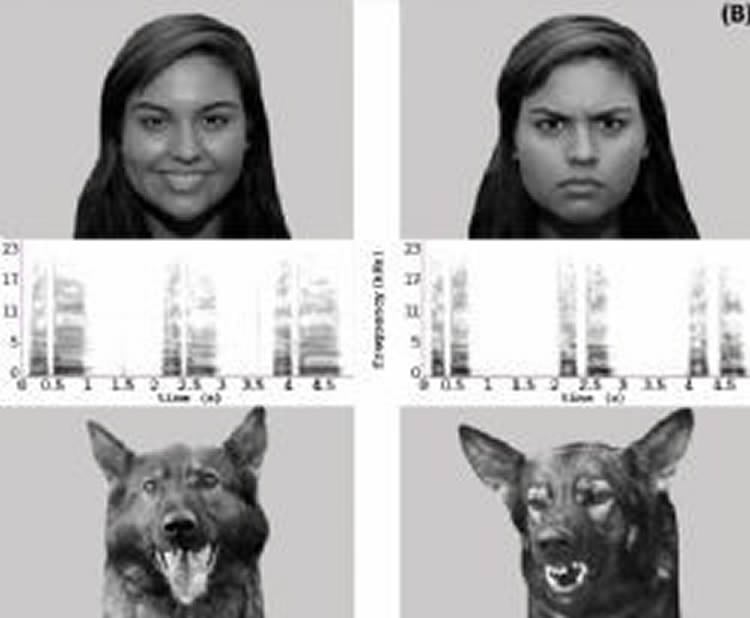Dogs can recognise emotions in humans by combining information from different senses – an ability that has never previously been observed outside of humans, a new study published today reveals.
For the first time, researchers have shown that dogs must form abstract mental representations of positive and negative emotional states, and are not simply displaying learned behaviours when responding to the expressions of people and other dogs.
The findings from a team of animal behaviour experts and psychologists the University of Lincoln, UK, and University of Sao Paulo, Brazil, are published in the Royal Society journal Biology Letters.
The researchers presented 17 domestic dogs with pairings of images and sounds conveying different combinations of positive (happy or playful) and negative (angry or aggressive) emotional expressions in humans and dogs. These distinct sources of sensory input – photos of facial expressions and audio clips of vocalisations (voices or barks) from unfamiliar subjects – were played simultaneously to the animals, without any prior training.
The team found the dogs spent significantly longer looking at the facial expressions which matched the emotional state (or valence) of the vocalisation, for both human and canine subjects.
The integration of different types of sensory information in this way indicates that dogs have mental representations of positive and negative emotional states of others.
Researcher Dr Kun Guo, from the University of Lincoln’s School of Psychology, said: “Previous studies have indicated that dogs can differentiate between human emotions from cues such as facial expressions, but this is not the same as emotional recognition.
“Our study shows that dogs have the ability to integrate two different sources of sensory information into a coherent perception of emotion in both humans and dogs. To do so requires a system of internal categorisation of emotional states. This cognitive ability has until now only been evidenced in primates and the capacity to do this across species only seen in humans.”
Co-author Professor Daniel Mills, from the School of Life Sciences at the University of Lincoln, said: “It has been a long-standing debate whether dogs can recognise human emotions. Many dog owners report anecdotally that their pets seem highly sensitive to the moods of human family members.

“However, there is an important difference between associative behaviour, such as learning to respond appropriately to an angry voice, and recognising a range of very different cues that go together to indicate emotional arousal in another. Our findings are the first to show that dogs truly recognise emotions in humans and other dogs.
“Importantly, the dogs in our trials received no prior training or period of familiarisation with the subjects in the images or audio. This suggests that dogs’ ability to combine emotional cues may be intrinsic. As a highly social species, such a tool would have been advantageous and the detection of emotion in humans may even have been selected for over generations of domestication by us.”
Source: Cerri Evans – University of Lincoln
Image Credit: The image is adapted from the University of Lincoln press release
Original Research: Full open access research for “Dogs recognize dog and human emotions” by Natalia Albuquerque, Kun Guo, Anna Wilkinson, Carine Savalli, Emma Otta, and Daniel Mills in Biology Letters. Published online January 13 2016 doi:10.1098/rsbl.2015.0883
Abstract
Dogs recognize dog and human emotions
The perception of emotional expressions allows animals to evaluate the social intentions and motivations of each other. This usually takes place within species; however, in the case of domestic dogs, it might be advantageous to recognize the emotions of humans as well as other dogs. In this sense, the combination of visual and auditory cues to categorize others’ emotions facilitates the information processing and indicates high-level cognitive representations. Using a cross-modal preferential looking paradigm, we presented dogs with either human or dog faces with different emotional valences (happy/playful versus angry/aggressive) paired with a single vocalization from the same individual with either a positive or negative valence or Brownian noise. Dogs looked significantly longer at the face whose expression was congruent to the valence of vocalization, for both conspecifics and heterospecifics, an ability previously known only in humans. These results demonstrate that dogs can extract and integrate bimodal sensory emotional information, and discriminate between positive and negative emotions from both humans and dogs.
“Dogs recognize dog and human emotions” by Natalia Albuquerque, Kun Guo, Anna Wilkinson, Carine Savalli, Emma Otta, and Daniel Mills in Biology Letters. Published online January 13 2016 doi:10.1098/rsbl.2015.0883






